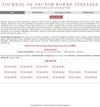2015-2020 年沙特阿拉伯贾赞地区登革热发病率的空间、时间和人口模式变化及相关气象因素。
IF 0.8
4区 医学
Q4 INFECTIOUS DISEASES
引用次数: 0
摘要
背景登革热对沙特阿拉伯的公共卫生构成了相当大的威胁,在季节性降雨为蚊子滋生创造了理想条件的贾赞,登革热疫情不断升级。要加强以证据为基础的预防政策,就必须阐明当地的流行病学动态。这项研究分析了 2015-2020 年期间贾赞登革热的时空、人口和气象模式。方法这项回顾性横断面研究利用了 3427 例登革热确诊病例的监测记录。描述性分析描述了地域、季节、年龄、性别和国籍分布特征。预测模型预测了到 2025 年的预期流行情况。回归分析确定了与每月病例数相关的气候因素。结果登革热表现出季节性峰值的变化,到 2019 年过渡到全年传播,这表明登革热已形成地方流行。病例每年聚集在不同的高负担地区,需要进行局部病媒控制。大多数受影响的人是年轻男性成年人,随着时间的推移,性别差距在缩小。沙特国民的发病率呈上升趋势,但非沙特公民的发病风险更高,这表明存在输入性威胁。结论加强监测、疫情预测、有针对性的控制活动以及以持续证据评估为基础的综合预防政策可以有效解决贾赞登革热的地方性传播问题。这项研究为优化沙特阿拉伯登革热控制的数据驱动决策提供了重要见解。本文章由计算机程序翻译,如有差异,请以英文原文为准。
Shifting spatial, temporal and demographic patterns of dengue incidence and associated meteorological factors in Jazan Region of Saudi Arabia from 2015-2020.
BACKGROUND
Dengue poses a considerable public health threat in Saudi Arabia, with escalating outbreaks in Jazan, where seasonal rains create ideal mosquito breeding conditions. Elucidating local epidemiological dynamics is imperative to strengthen evidence-based prevention policies. This study analyzed the spatiotemporal, demographic, and meteorological patterns of dengue in Jazan from 2015-2020.
METHODS
This retrospective cross-sectional study utilized surveillance records for 3427 confirmed dengue cases. Descriptive analyses characterized geographic, seasonal, age, sex, and nationality distributions. Forecasting models project expected epidemics through 2025. Regression analysis identified climate factors associated with monthly case counts.
RESULTS
Dengue exhibited shifting seasonal peaks, transitioning into year-round transmission by 2019, indicating endemic establishment. Cases clustered in different high-burden sectors annually, requiring localized vector control. The majority of affected individuals were young male adults, with gender gaps narrowing over time. Saudi nationals had an escalating incidence, but non-citizens showed a higher risk, signaling importation threats. Seasonal outbreaks were associated with temperature, wind speed, and direction.
CONCLUSION
Enhanced surveillance, outbreak forecasting, targeted control activities, and integrated prevention policies grounded in continuous evidence assessment can effectively address endemic dengue transmission in Jazan. This study provides key insights to optimize data-driven decision-making for dengue control in Saudi Arabia.
求助全文
通过发布文献求助,成功后即可免费获取论文全文。
去求助
来源期刊

Journal of Vector Borne Diseases
INFECTIOUS DISEASES-PARASITOLOGY
CiteScore
0.90
自引率
0.00%
发文量
89
审稿时长
>12 weeks
期刊介绍:
National Institute of Malaria Research on behalf of Indian Council of Medical Research (ICMR) publishes the Journal of Vector Borne Diseases. This Journal was earlier published as the Indian Journal of Malariology, a peer reviewed and open access biomedical journal in the field of vector borne diseases. The Journal publishes review articles, original research articles, short research communications, case reports of prime importance, letters to the editor in the field of vector borne diseases and their control.
 求助内容:
求助内容: 应助结果提醒方式:
应助结果提醒方式:


